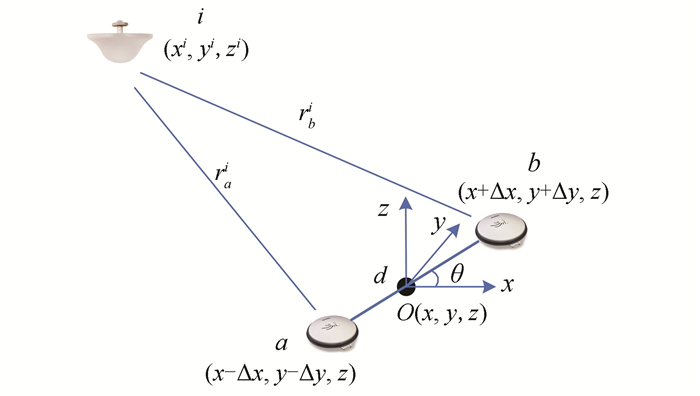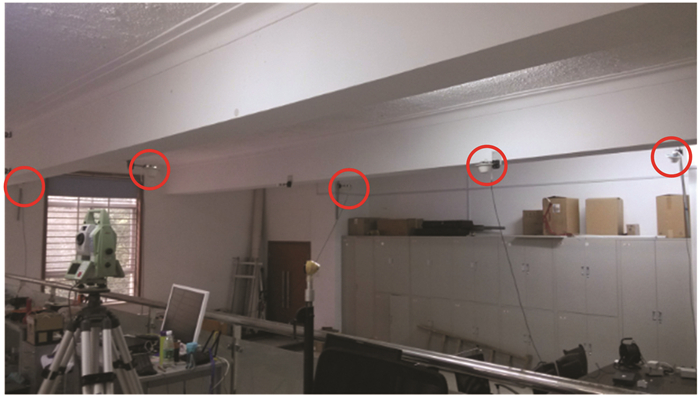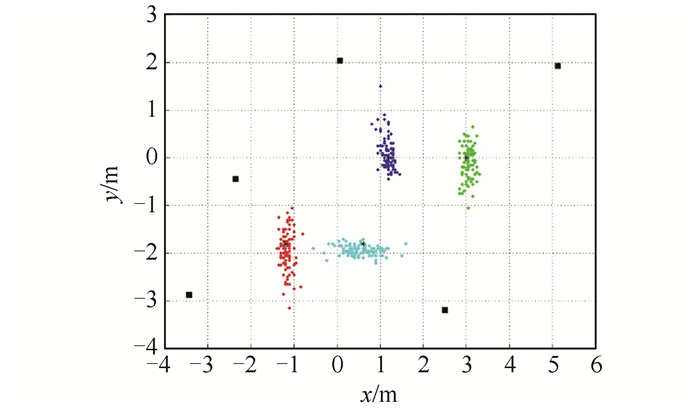-
摘要: 针对卫星定位技术无法应用于室内环境的情况,提出了一种新颖的利用载波相位差值的伪卫星定位方法,该方法能够实现亚米级的定位精度,而且无需基准站的支持,无需伪卫星之间的时钟同步,也不需要求解整周模糊度。构建了伪卫星定位的系统模型,并阐述了利用载波相位差值进行定位的基本原理。首先将双天线接收机输出的两组载波相位测量值进行单次差分操作,消除共有误差带来的影响,然后通过非线性最小二乘方法迭代解算出双天线连线中点的空间位置。仿真结果和基于双通道软件接收机的实测数据均证明了该方法的可行性,能够作为现有室内定位技术的有效补充。Abstract: GNSS receiver could not be used in indoor environments. This paper proposes a novel pseudolite positioning approach utilizing carrier phase difference measurements, which can achieve sub-meter accuracy without the support of a base station, and without the need of synchronization between pseudolites. In addition, in the proposed approach, the integer ambiguity resolution is unnecessary as well. This research builds up system model for pseudolite positioning and proposes basic principle for this positioning method utilizing carrier phase difference measurements. First, two sets of carrier phase measurements output from a dual-antenna receiver are differentiated in order to cancel out the common errors. Then a non-linear least square adjustment method is used to solve spatial coordinates of center point of the dual-antenna iteratively. Simulation results and experiment outputs from a dual-antenna software receiver verified the feasibility of this approach. This pseudolite positioning approach can be regarded as an effective complement of existing indoor positioning techniques.
-
Keywords:
- indoor positioning /
- pseudolite /
- carrier phase /
- dual-antenna /
- software receiver
-
-
表 1 5颗伪卫星的三维坐标
Table 1 Three-dimensional Coordinates of Five Pseudolites
伪卫星号 伪卫星三维坐标/m x y z 1 2.506 -3.186 3.204 2 0.064 2.033 2.952 3 5.124 1.930 3.128 4 -2.358 -0.438 2.991 5 -3.444 -2.871 3.255 表 2 天线方位角取不同值时的定位结果统计
Table 2 Statistical Positioning Results when Antenna Azimuth Takes Different Values
测试点号 θ=0° θ=45° θ=90° x/m y/m z/m θ/(°) x/m y/m z/m θ/(°) x/m y/m z/m θ/(°) 1 0.13 0.33 0.34 1.85 0.75 0.60 0.91 4.89 0.31 0.08 1.58 1.23 6 0.12 0.34 0.39 1.87 0.12 0.34 0.39 1.87 0.30 0.07 1.56 1.08 11 0.11 0.25 0.34 1.44 0.29 0.26 0.79 1.24 0.30 0.07 1.53 1.50 16 0.11 0.59 0.36 2.37 0.11 0.59 0.36 2.37 0.41 0.10 1.62 1.34 表 3 4个测试点的定位结果统计
Table 3 Statistical Positioning Results for Four Test Points
测试点
颜色平均误差 最大误差 x/m y/m x/m y/m 红 0.15 0.29 0.34 1.16 蓝 0.21 0.35 0.47 1.48 绿 0.11 0.20 0.33 1.02 青 0.23 0.22 1.33 0.39 -
[1] Gu Y Y, Anthony L, Niemegeers I. A Survey of Indoor Positioning Systems for Wireless Personal Networks[J]. IEEE Communications Surveys & Tutorials, 200911(1):13-32 http://cn.bing.com/academic/profile?id=ac62f913c9565afdeb83c0f3768d99b3&encoded=0&v=paper_preview&mkt=zh-cn
[2] Wang J. Pseudolite Applications in Positioning and Navigation Progress and Problems[J]. Journal of Global Positioning Systems, 2002, 1(1):48-56 doi: 10.5081/jgps
[3] Rizos C, Barnes J, Gambale N. Experimental Results of Locata: A High Accuracy Indoor Positioning System[C]. International Conference on Indoor Positioning and Indoor Navigation, Zurich, Switzerland, 2010
[4] Xu R, Chen W, Xu Y, et al. A New Indoor Positioning System Architecture Using GPS Signals[J]. Sensors, 2015, 15:10074-10087 doi: 10.3390/s150510074
[5] Chongwon K, Hyoungmin S, Taikjin L, et al. A Pseudolite-Based Positioning System for Legacy GNSS Receivers[J]. Sensors, 2014, 14:6104-6123 doi: 10.3390/s140406104
[6] Naohiko K, Shusuke M, Satoshi K, et al. Indoor and Outdoor Seamless Positioning Using Indoor Messaging System and GPS[C]. International Conference on Indoor Positioning and Indoor Navigation, Guimarães, Portugal, 2011
[7] Daniele B, Ciro G. Asynchronous Pseudolite Navigation Using C/N0 Measurements[J]. Journal of Navigation, 2015, 69(3):639-658 http://cn.bing.com/academic/profile?id=fae2398b5e40f1eb17c3c88edbf2bcf4&encoded=0&v=paper_preview&mkt=zh-cn
[8] Daniele B, Ciro G. Indoor Navigation Using Asynchronous Pseudolites[C]. 6th European Workshop on GNSS Signals and Signal Processing, Munich, Germany, 2013
[9] Yoshihiro S, Hiroaki A, Takuji E, et al. Hyperbo-lic Positioning with Proximate Multi-channel Pseu-dolite for Indoor Localization[C]. Proceedings of the IGNSS Symposium 2013, Gold Coast, Australia, 2013
[10] Samama N, Vervisch-Picois A, Taillandier-Loize T. A GNSS-like Indoor Positioning System Implementing an Inverted Radar Approach[C]. International Conference on Indoor Positioning and Indoor Navigation, Alcalá de Henares, Spain, 2016






 下载:
下载:





